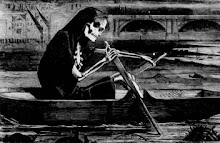Sunday last, we visited the de Young museum to catch the penultimate weekend of the Dale Chihuly exhibition. I'll come back to that later in the week, but meanwhile on the way from the car park into the exhibition there was a small collection of teapots fashioned by Charles Krafft set up on stands lining the corridor.
Of all the six or so items on show, the one above stood out for me as having real impact. In checking on the web afterwards it's clear that Krafft's fashioned this item in a number of differing ways so this is a theme the artist has come back to more than once.
According to the display tag at the museum, the word "Idaho" refers to the known association in people's minds between that state and neo-Nazi groups such as the Aryan Brotherhood who base themselves there. The description also noted the way the lid of the teapot was fashioned as a yarmulke, and that the handle and spout create a strong impression of devil-like horns.
Poking at his MySpace page reveals that Krafft has also taken the concept of Spode ware - aka bone china - a step further, creating a version that uses the remains from human cremation instead of animal bones. I don't believe this piece was fashioned from Krafft's trademarked "Spone" - at least, I hope it isn't for obvious reasons - but other items can be, perhaps a dish or a vase, if having breakfast off a loved one is how you want to remember them of course.
Back to the teapot. The notion of taking the bloodiest dictator that the world has likely ever known and fashioning his likeness into a common kitchen item such as a teapot is either a stroke of artistic genius or an utterly tasteless piece of sensationalism; personally, I opt for the first. Compared with another version shown on Krafft's MySpace page (second link above) this one conveys an even stronger impression of absolute menace; the blank eyes alone speaking volumes about the bottomless pit of hatred Hitler was able to contain. Krafft here reminds us that Hitler's power came from the mundane, the everyday German who, by sitting round the kitchen table and doing nothing, was complicit in his rise to power and assumption of total power without which the Reich could not have pursued its totalitarian agenda of conquest and extermination.
Given how quickly we seem to be able to forget the lessons of history - even those learned so painfully barely one lifetime ago - there should be one of these in every kitchen across the face of the globe. Surely seeing - using it even - everyday of the week might just be enough to help prevent the human race allowing this kind of madness ever to overtake us again? Alas, history also teaches us that we very quickly distance ourselves; we subsequently forget; and we then feel free to fall into the same abyss time and time again, a human failing not even the greatest of artists has ever been able to prevent.



No comments:
Post a Comment